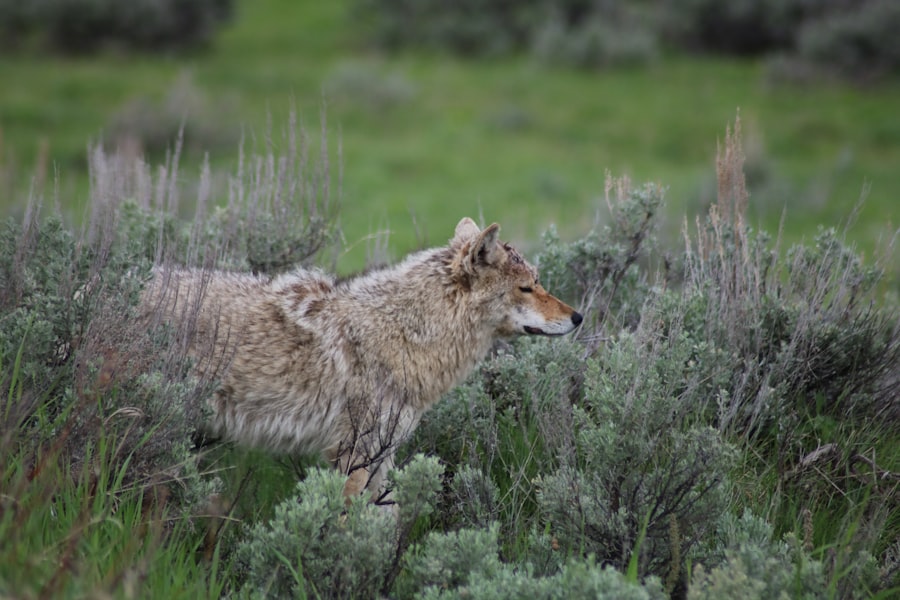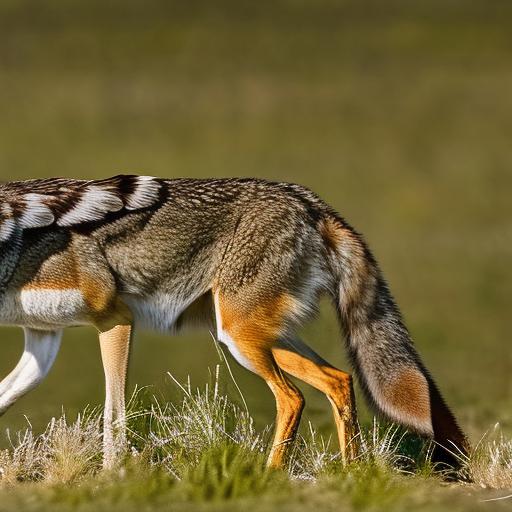Geese infestation is a growing problem in many areas, causing significant damage to the environment and posing health risks to humans. These large birds are known for their aggressive behavior, territoriality, and excessive droppings, which can lead to a variety of issues. Geese can destroy crops, damage lawns and gardens, contaminate water sources, and create safety hazards on roads and runways. Additionally, their droppings can carry harmful bacteria such as E. coli and Salmonella, which can pose health risks to humans.
Key Takeaways
- Geese infestation is a common problem that can cause damage to property and pose health risks.
- Coyotes can be effective in controlling geese population, but using real coyotes is not always practical or safe.
- Fake coyotes are a non-lethal and effective way to deter geese from an area.
- Fake coyotes work by mimicking the appearance and behavior of real coyotes, which scares geese away.
- The best type of fake coyote for geese deterrence depends on the specific situation and environment.
The Role of Coyotes in Controlling Geese Population
Coyotes are natural predators of geese and play a crucial role in controlling their population. Coyotes are highly adaptable animals that have successfully adapted to urban environments, including parks, golf courses, and residential areas where geese infestations are common. They are known for their hunting skills and ability to prey on a variety of animals, including geese.
Coyotes primarily hunt geese by ambushing them near water bodies or open fields. They use their speed, agility, and stealth to surprise the geese and catch them off guard. By preying on geese, coyotes help maintain a balance in the ecosystem and prevent overpopulation.
Fake Coyotes: A Non-Lethal Way to Deter Geese
While coyotes are effective in controlling geese populations, introducing live coyotes into urban areas is not always feasible or desirable due to safety concerns. However, there is an alternative solution that mimics the presence of coyotes without the risks associated with live predators – fake coyotes.
Fake coyotes are life-sized replicas of real coyotes that are designed to scare away geese. They are made from durable materials such as plastic or fiberglass and are often painted to resemble real coyotes. These decoys can be placed in areas where geese are causing problems, such as parks, golf courses, or residential areas.
How Do Fake Coyotes Work to Keep Geese Away?
Fake coyotes work by exploiting the natural fear and instinctual behavior of geese. Geese are naturally wary of predators and will avoid areas where they sense a potential threat. When geese see a fake coyote, they perceive it as a real predator and will instinctively avoid the area.
The effectiveness of fake coyotes lies in their realistic appearance and strategic placement. The decoys are designed to mimic the posture and body language of a hunting coyote, which triggers a fear response in geese. Additionally, placing the decoys in areas where geese congregate, such as near water bodies or feeding areas, increases their effectiveness.
Types of Fake Coyotes: Which is the Best for Geese Deterrence?
There are several types of fake coyotes available on the market, each with its own advantages and disadvantages. The most common types include stationary decoys, motion-activated decoys, and remote-controlled decoys.
Stationary decoys are the simplest and most affordable option. They are placed in a fixed position and rely on their realistic appearance to deter geese. While they can be effective in some situations, they may become less effective over time as geese become accustomed to their presence.
Motion-activated decoys are equipped with sensors that detect movement and trigger a realistic motion in the decoy. This movement can startle geese and make them believe that the decoy is a real predator. Motion-activated decoys are more effective than stationary decoys because they create a dynamic and unpredictable presence.
Remote-controlled decoys offer the highest level of control and customization. They can be operated from a distance using a remote control, allowing users to mimic the movement and behavior of a real coyote. Remote-controlled decoys are particularly effective in areas with high geese populations or where geese have become habituated to other types of decoys.
Where to Place Fake Coyotes for Maximum Effectiveness?

To maximize the effectiveness of fake coyotes, it is important to strategically place them in areas where geese congregate or cause problems. Some key locations to consider include:
1. Near water bodies: Geese are attracted to water bodies for feeding and nesting. Placing fake coyotes near lakes, ponds, or rivers can deter geese from entering these areas.
2. Feeding areas: Geese often gather in open fields or grassy areas to feed. Placing fake coyotes in these areas can discourage geese from feeding and force them to find alternative locations.
3. Roosting sites: Geese typically roost near water bodies or on elevated structures such as rooftops or trees. Placing fake coyotes near these roosting sites can discourage geese from settling in these areas.
4. Pathways and walkways: Geese can create safety hazards on pathways and walkways by leaving droppings or becoming aggressive towards pedestrians. Placing fake coyotes along these routes can deter geese from using them.
Maintenance and Care of Fake Coyotes for Long-Term Use
To ensure the long-term effectiveness of fake coyotes, proper maintenance and care are essential. Here are some tips for maintaining and caring for fake coyotes:
1. Regular cleaning: Fake coyotes can accumulate dirt, dust, and bird droppings over time, which can reduce their effectiveness. Regularly clean the decoys using mild soap and water to remove any debris.
2. Repositioning: Geese may become accustomed to the presence of fake coyotes if they remain in the same position for an extended period. Periodically reposition the decoys to create a sense of unpredictability and maintain their effectiveness.
3. Visual deterrents: Supplement the use of fake coyotes with other visual deterrents, such as reflective tape or scare balloons. These additional deterrents can enhance the effectiveness of fake coyotes by creating a more dynamic and intimidating environment for geese.
4. Storage during off-season: If geese infestation is seasonal in your area, consider storing the fake coyotes during the off-season to prevent damage from weather conditions or vandalism. Properly store the decoys in a dry and secure location.
Alternatives to Fake Coyotes: Other Methods to Keep Geese Away
While fake coyotes are an effective and humane solution for geese control, they can be complemented with other methods to enhance their effectiveness. Some alternative methods to consider include:
1. Habitat modification: Geese are attracted to areas with abundant food sources and open spaces for nesting. Modifying the habitat by reducing food availability, removing nesting sites, or installing barriers can discourage geese from settling in these areas.
2. Sonic deterrents: Sonic devices emit loud noises or predator calls that can scare away geese. These devices can be effective in deterring geese from specific areas, but they may also disturb nearby residents or wildlife.
3. Chemical repellents: Chemical repellents can be applied to grassy areas or crops to make them unpalatable to geese. However, these repellents may have environmental impacts and should be used with caution.
4. Border collies: Border collies are highly intelligent herding dogs that can be trained to chase and harass geese without causing harm. The presence of a well-trained border collie can effectively deter geese from an area.
Benefits of Using Fake Coyotes for Geese Control
Using fake coyotes for geese control offers several benefits:
1. Non-lethal: Fake coyotes provide a humane solution for geese control without causing harm to the birds or other wildlife. They offer a safe and ethical alternative to lethal methods such as hunting or trapping.
2. Cost-effective: Fake coyotes are a cost-effective solution compared to other methods of geese control. Once purchased, they require minimal maintenance and can be used for multiple seasons.
3. Environmentally friendly: Fake coyotes do not rely on chemicals or harmful substances, making them an environmentally friendly option for geese control. They do not pose any risks to the ecosystem or other non-target species.
4. Versatile: Fake coyotes can be used in a variety of settings, including parks, golf courses, residential areas, and agricultural fields. They can be easily moved and repositioned as needed to target specific problem areas.
Using Fake Coyotes as a Safe and Effective Solution for Geese Infestation
Geese infestation is a significant problem that can have detrimental effects on the environment and human health. Fake coyotes offer a safe, humane, and effective solution for geese control. By mimicking the presence of natural predators, fake coyotes can deter geese from problem areas without causing harm to the birds or other wildlife. With proper maintenance and strategic placement, fake coyotes can provide long-term relief from geese infestation while preserving the balance of the ecosystem.
If you’re interested in finding out more about using fake coyotes to keep geese away, you might also want to check out this informative article on Poultry Wizard’s website. They discuss the importance of providing a coop for turkeys and offer valuable insights on how to create a suitable environment for them. You can read it here: https://poultrywizard.com/keeping-turkey/do-turkeys-need-a-coop/. Additionally, if you’re considering raising chickens for your family, Poultry Wizard has another helpful article that provides guidance on determining the ideal number of chickens needed for a family of four. Check it out here: https://poultrywizard.com/keeping-chickens/how-many-chickens-do-you-need-for-a-family-of-4/. Lastly, if you’re looking for tips on building a chicken coop in Muskegon, Poultry Wizard has got you covered with their comprehensive guide. Find it here: https://poultrywizard.com/keeping-chickens/chicken-coop-muskegon/.
Meet Walter, the feathered-friend fanatic of Florida! Nestled in the sunshine state, Walter struts through life with his feathered companions, clucking his way to happiness. With a coop that’s fancier than a five-star hotel, he’s the Don Juan of the chicken world. When he’s not teaching his hens to do the cha-cha, you’ll find him in a heated debate with his prized rooster, Sir Clucks-a-Lot. Walter’s poultry passion is no yolk; he’s the sunny-side-up guy you never knew you needed in your flock of friends!







